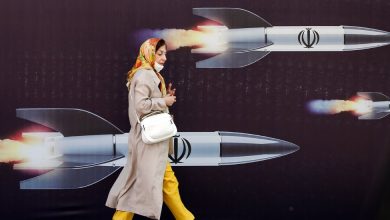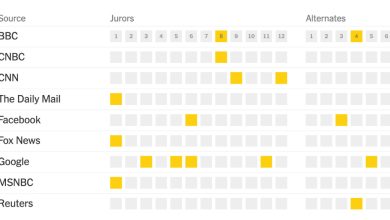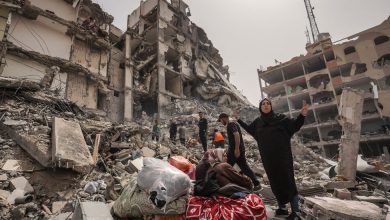North Korea Launches Three Ballistic Missiles

SEOUL — North Korea launched three ballistic missiles toward the waters off its east coast on Wednesday, South Korea’s military said, as President Biden was wrapping up a trip to the region.
It was North Korea’s 17th missile test this year. The two missiles were launched from Sunan, near Pyongyang, the North’s capital, at 6 a.m., 6:37 a.m. and 6:42 a.m., the South Korean military said. American and South Korean officials have warned in recent weeks that the North was ready to conduct either a nuclear test or an intercontinental ballistic missile test.
It last conducted an ICBM test on March 24, breaking a self-imposed moratorium on such tests that had been in place since 2018.
The missile launches on Wednesday were a strong signal from the North that it was embarking on a new cycle of tensions in the Korean Peninsula despite the country’s first reported outbreak of the coronavirus. It also constituted North Korea’s first reaction to Mr. Biden’s trip to the region, where he met with the leaders of the American allies South Korea and Japan and vowed to step up measures, including joint military exercises, to help deter the growing nuclear and missile threat from the North.
In a meeting with President Yoon Suk-yeol of South Korea in Seoul last Saturday, Mr. Biden said that the United States would bolster the alliance and increase deterrence in the face of the North Korean threat. Mr. Biden and Mr. Yoon announced that they would explore ways to expand the joint military exercises that had been canceled or scaled down under President Donald J. Trump.
Read More on Biden’s Trip to Asia
- Trade Policy: The new trade deal announced by President Biden during his trip to Asia is based on two big ideas: containing China and moving away from a focus on markets and tariffs.
- In an Awkward Spot: Mr. Biden’s remarks about the future of U.S. defense of Taiwan complicate diplomacy for the Indo-Pacific bloc, particularly for Australia.
- Strategic Intent?: Some view President Biden’s words as just a gaffe, but they are consistent with the administration’s new policy toward the territory.
- Veering Off Script: Offhand comments that vary from the official talking points, the ones he made in Tokyo, have become a recurring feature of the Biden presidency.
Mr. Yoon himself has been highly skeptical of North Korea, as well, saying that the efforts by his predecessor, Moon Jae-in, to engage with North Korea in dialogue and reconciliation have failed to roll back its nuclear weapons program.
When Mr. Yoon was sworn into office on May 10, he dangled “an audacious plan” to vastly improve the North’s economy and its people’s quality of life. But like his conservative predecessors, he attached an important caveat: Such economic largess would be possible only “if North Korea genuinely embarks on a process to complete denuclearization.”
The missile test on Wednesday indicated that North Korea was not interested in nuclear disarmament talks anytime soon. In a speech delivered during a nighttime military parade in April, North Korea’s leader, Kim Jong-un, reiterated that his people should prepare for a standoff with the United States “for a long period of time.” At the same time, he vowed to expand his arsenal of nuclear warheads and intercontinental ballistic missiles and other delivery vehicles “at the fastest possible speed.”
Mr. Kim has also appeared to adopt a more aggressive nuclear doctrine in recent weeks.
In the same speech last month, Mr. Kim seemed to take a page from the playbook of President Vladimir V. Putin of Russia when he warned that his nuclear arsenal was not just to deter foreign invasion, but to also be used “if any forces try to violate the fundamental interests of our state.”
Last month, Mr. Kim’s sister and spokeswoman, Kim Yo-jong, said North Korea could use nuclear weapons “at the outset of war.” After a short-range missile test last month, Mr. Kim said he was improving the “efficiency” of battlefield or “tactical nukes.”
North Korea declared a halt to all nuclear and ICBM and nuclear tests to set the stage for the first summit meeting between Mr. Kim and Mr. Trump in 2018. But the unprecedented diplomacy ended without an agreement on how to dismantle North Korea’s nuclear program or when to lift sanctions.
Mr. Kim has since vowed to find a “new way” to deal with Washington and started testing a variety of new missiles. Analysts viewed his moves as raising the stakes in his confrontation with Washington and its allies by rapidly amassing a fleet of nuclear-tipped missiles and altering his country’s nuclear doctrine.
The new cycle of tensions highlights an uncomfortable truth both for Mr. Yoon and the Biden administration: Despite decades of negotiations and sanctions, North Korea’s nuclear capabilities have only become stronger and more dangerous.
“North Korea continues to improve, expand and diversify its conventional and nuclear missile capabilities, posing an increasing risk to the U.S. homeland and U.S. forces, allies, and partners in the region,” John Plumb, the U.S. assistant secretary of defense for space policy, told the Senate Armed Services Committee earlier this month. “Most of North Korea’s ballistic missiles have an assessed capability to carry nuclear payloads.”




